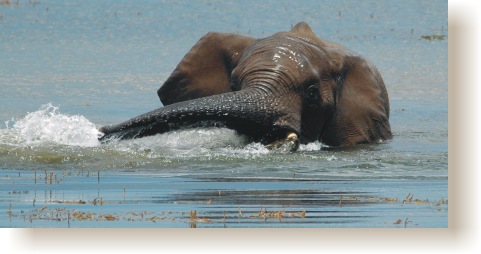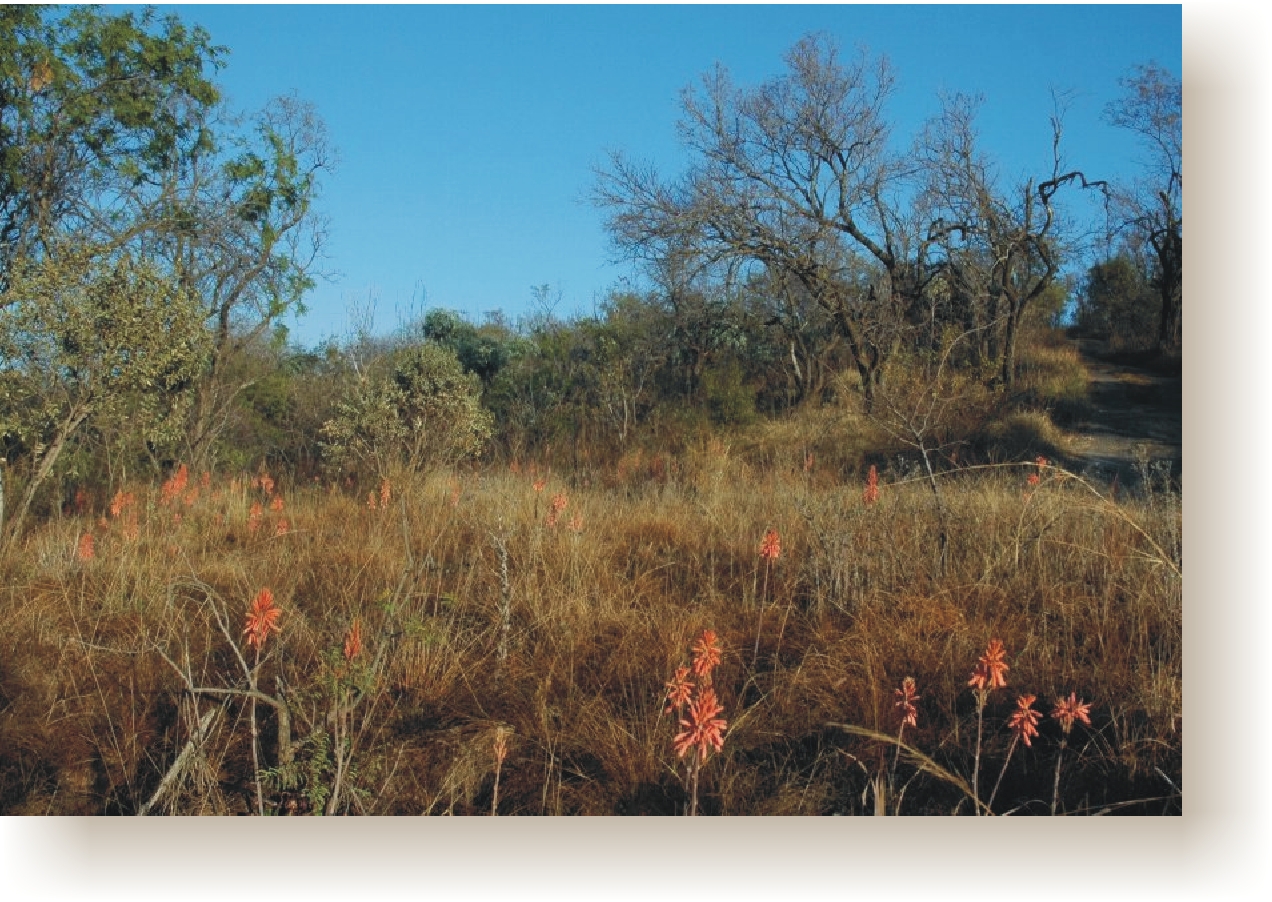|
Botswana has some of the most beautiful wildlife areas in Africa.
Central Botswana consist of relatively flat Kalahari sand-veldt, which is a semi-dessert
thorn veldt and is not as well frequented as the world-famous delta or Okavango pan-handle
are. So, a camping trip was planned to further explore the central regions with a couple
of friends in February. The trip was planned in the rainy season when the vegetation is at
its most luxuriant and the stormy skies form the most awe inspiring backdrops to the
‘big-sky‘ vistas.
On our first evening, while setting up camp we noticed flocks of birds swarming in tight
aggregations and guessed it must be the termite ‘flying ants’ emerging. We set
off to the nearest flock and had the most fantastic experience with hundreds of Amur
falcons, black and yellow-billed kites, red-footed kestrels, fork-tailed drongos etc, all
swarming around us catching termites (mainly in their claws). It was breathtakingly
beautiful with all these wild energetic silhouettes swirling and darting and the setting
sun beautifully illuminating the clouds behind. |
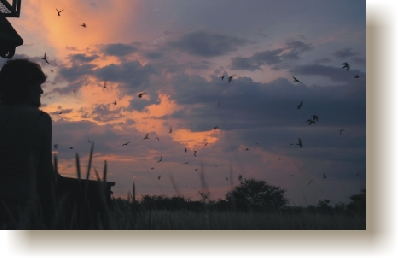 |
 |
Just before dawn on the third day we heard lions roaring close by
and scrambled out of our tents hoping for a glimpse of them. Standing in the dark we
managed to pick up a lioness in the torch light just a few metres off. It had rained in
the early hours and the lions, preferring to use the dry road, passed just a few metres in
front of our camp. They were a mating trio comprising this lioness with the coalition of
brothers which hold the territory and we were lucky enough to see them on a number of
occasions. The female had a nasty black eye which we surmised to have been caused from an
animal’s hoof, perhaps while hunting. Luckily the eye itself was not damaged (as it
may have been, if a venomous snake had spat in it?). |
| In the
heat of the day herds of springbok, gemsbok and wildebeest sheltered in the shade of the
stands of acacia luederitzii and tortilis trees which mushroom out of the flat, short
grassed pans. On many occasions we would have an afternoon thunderstorm and once it had
passed the landscape would be bathed in intense, warm light against dark, brooding
thunderclouds which was too fantastic to behold! |
  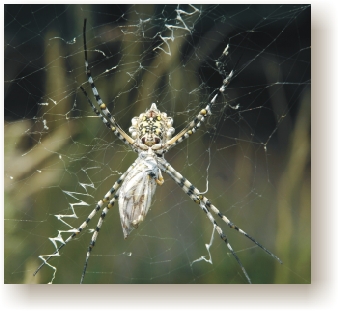 |
Having lived in Africa all our lives we are spoiled rotten with many
wonderful sightings of animals through the years, in particular the big five, so on some
days we travelled only a couple of kilometres enjoying all the small things like insects,
reptiles, birds, flowers etc. We spent ages watching birds bathing in road puddles and the
beauty of being in the Botswanan Game Reserves is the freedom to get out of the vehicle in
order to explore, photograph, taste, smell and touch the wildlife. You just have to be
careful not to be on the receiving end of any of the nasties.
Travelling a little further north we entered the Nxai Pans Game Reserve where I was bowled
over by the harsh beauty and bareness of this place. Some areas had a 360 degree view of
sparse grass with only small patches of windswept scrub bushes for as far as the eye could
see, which in winter I imagine must be a view of mostly sand and sticks. |
Being an artist this place has had a special allure and is one that I have long wanted to
visit. An early explorer, hunter, map-maker and artist, Thomas Baines, nearly 150 years
ago tarried his expedition long enough to do a watercolour sketch of a stand of baobabs
(now called Baines‘s baobabs) which are found in this reserve growing on the edge of
Kaudikum pan. It always amazes me how tough these early pioneers were, as here he stopped
to sketch these magnificent giants in this inhospitable, windy, semi-desert with scarcity
of water for both man and beast and no notion of where they would next fill their water
barrels. Stark and devoid of leaves, the immense size and beauty of these trees seduced
him and he recorded them for prosperity, and they enchanted us too! |

|
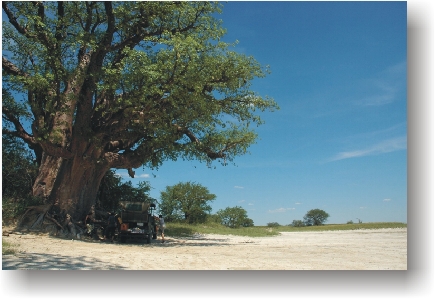 |
Our fist evening started with an elephant coming onto the pan from
the south and making straight towards our island camp. Sadly he must have heard us and did
a silly walk around in circles in the middle of the pan till he eventually made up his
mind to go to Baines’s baobabs instead. It looked like he was after the large cream
of tartar seeds which seemed to be a great delicacy.
Each morning Jackals called before dawn, and scenes of gemsbok and tsessebe dotted the
open pan before our camp. We spent some days ambling around the islands and
rain-water-pans (which smelled just like sea estuaries) looking at interesting stones and
silcrete chunks on the crunchy surfaces. We photographed wild Hoodia plants (world
renowned now for their appetite suppressants), and watched water birds like pelicans,
yellow-billed storks, greater flamingos, ruffs, red-billed teals, plovers and sandpipers
all feeding in the salty puddles. |
|
| The fresh(er) water pans were visited by thousands of zebras who
came down to drink in their family kingships. The pattern seemed to be - walk peacefully
to the waterhole, drink (some even got into the water for cleaner, less muddied water) and
then amble off a little. At this point the stallions then became quite stroppy, picking
fights with each other, kicking and biting and throwing up huge dust clouds. Wave upon
wave of zebras arrived to drink and in amongst the medley of striped legs, cape teals,
shore birds, waders, flocks of red-capped larks and abdims storks came and went, all
sharing this precious water resource. A little way off members of a pride of lions with
cubs could be seen lazing under bushes out of the mid-day heat. Twenty or thirty zebras
formed a circle around the lions and stood staring at them for ages, which was so weird to
see, and the following day the lions made a kill - were they sick of being stared at or
just hungry? |
  |
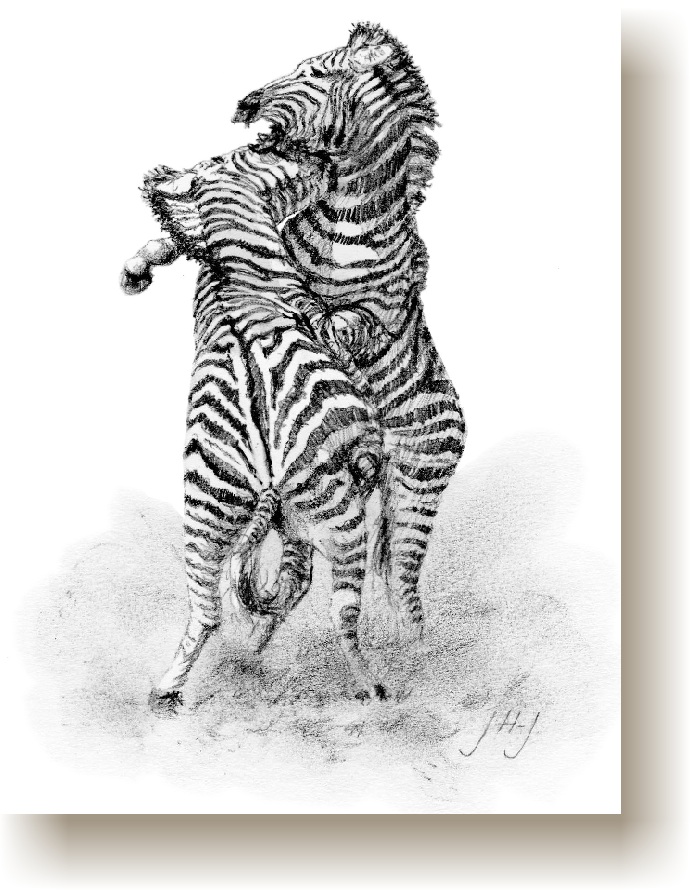  |
| These herds are remnants of the centuries-old zebra migrations which
saw millions of animals migrate from the lush delta region into the northern Kalahari in
the summer and back again in the winter months when these seasonal water holes dry up. |
|
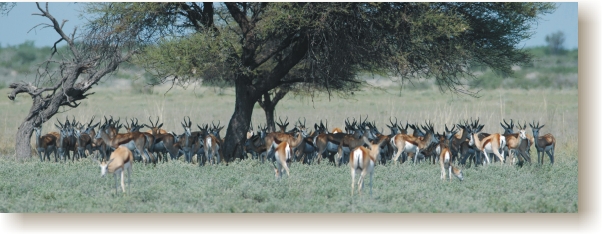 |
| Giraffe are such curious creatures and one afternoon we decided to
attract a distant ‘journey’ closer for better photographs and so Moira crawled
around in the road ahead, snorting and waving her arms under a sarong which was a very
funny sight, and the astounded giraffes kept coming closer and closer to get a better look
at this strange apparition. What a super adventure and what fantastic memories and
experiences! |
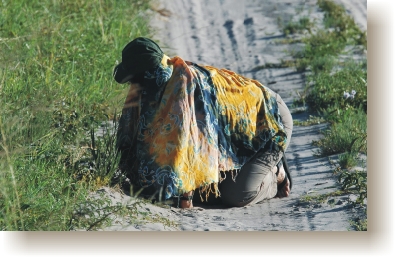 |
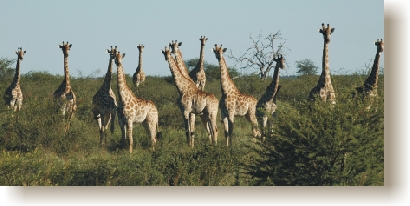 |
|
|
|
My studio is only an hour and a half from
the ‘big five’ Pilanesberg Game Reserve and this little gem serves as a
wonderful place to get inspiration and reference material which I use in many of my
drawings and paintings. To observe wildlife and birds in their natural habitat and see how
they utilise their surroundings for homes and food is always fascinating. Needless to say
spring and summer are my favourite times of the year, when the migratory birds arrive
back, a lot of flowers and trees blossom, insects are bountiful and most creatures have
babies. The rains come and wash the dust from the landscape and form majestic
thundercloud-backdrops to the afternoon skies, and rivers run again and the dams fill up.
| On a early summer trip I was fortunate enough to see elephants
bathing on a few occasions and while the dam levels were still relatively low these
magnificent pachyderms would find a spot to submerge for many minutes with little more
than their trunk tips protruding like periscopes out of the water. |
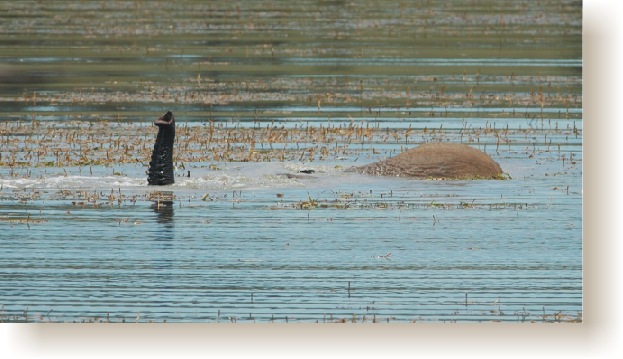
| They could breath
and smell if danger was approaching without even having to pop their heads up to have a
look. I was interested to see that breeding herds with small babies did not venture in to
swim as the lone bulls did and I wondered if this was for fear of the little ones being
caught by the large crocodiles which inhabit these dams. |
|
|
|
Another fascinating sight was the yellow-billed storks
‘fishing’. They wade out into thigh-deep water and then shoot one wing high into
the air to cast a shadow onto the water and at the same time rhythmically move a leg
around a few times to stir up the mud and chase a fish or amphibian into the waiting beak
which was held partially open.
On this trip beautiful ground orchids, Eulophia streptopetala, were found in full bloom
and photographed although fresh specimens are needed in order to do a botanically-accurate
painting it‘s prohibited to remove plant matter from a Game Reserve and so
photographs had to do. |
 |
| With wilderness areas shrinking at an alarming rate and many species
being threatened and in decline globally, one blessing is the success that South Africa
has had with breeding rhino. It always makes my heart soar when I come across rhino in the
wild. It is a privileged and a sight I never saw while growing up and this joy was doubled
when sighting a rare black rhino out in the open near Mankwe dam one hot afternoon. Sadly
it got a fright and ran off before coming down to the waters edge. Perhaps drinking along
a well wooded tributary would be more to it’s liking? |
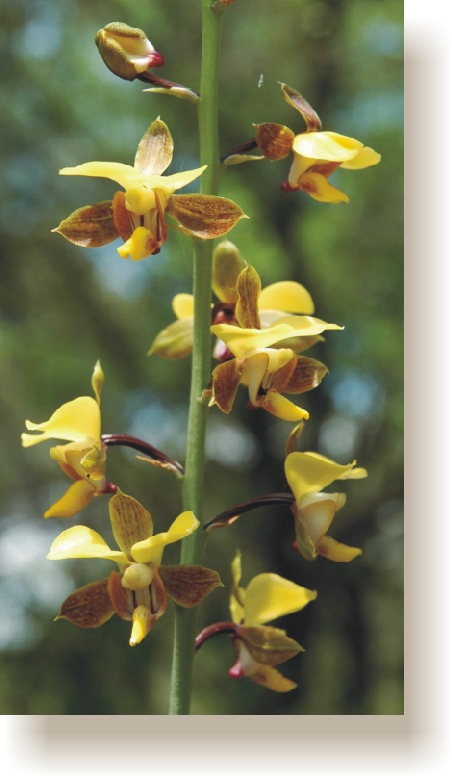 |
 |
|
|
|
A place as ancient as the beginning of time and as
fascinating as the story of life itself… A studio, nestling between the valleys and
kloofs where bankenveld and bushveld meet, where game still roam and a vast variety of
silver leaved plants occur in scattered patches in the grassland. Where ghosts of ancient
and fascinating creatures who once roamed this abundant and diverse ecosystem never cease
to intrigue my mind and satisfy my soul. A hundred times older than Everest and the very
cradle of humanity, where the rocks reveal the worlds richest hominid fossils dating back
millions of years. Records of the abundant variety of life through the eons that make this
place their home, stirs my core today even though the sabre-toothed tigers and giant
hyenas that once roamed here are now just friendly phantoms in my mind. |

Fossil Remains |
|
|
Gorgonopsian (Terrible Eye)
|
My daily strolls among the 3000 million year-old rocks that crust these ridges, the oldest
in the world and a record of a vast inland sea, heaving and rifting plates and the shaping
and honing of unique animal and plant life over millions of years. And it shapes me too -
every day. This is my springboard for field trips that in recent times have taken me to
the Okavango Delta, the craggy Drakensberg, Mabuasehube in the Kgalagadi desert, the
ranging wildflower fields that stretch for miles in Namaqualand, the vast bird nesting
sites of Lake Ngami and Magadigadi salt pans and more. I use these trips to conceive
pictures and gather detailed field references. My paintings are then brought to life in my
studio, using field notes, sketches, photographic references and research on birds,
plants, animals and invertebrates.
My aim is to capture the rich tapestry of nature, habitat, light, posture and jizz; to
portray the very essence of organisms, their symbiosis and the interconnectedness of life.
So many subjects, so little time…
|
|
















